| 7 December |
• yesterday • tomorrow |
| Memorial of Saint Ambrose, Bishop and Doctor of the Church |
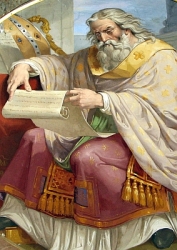
• The Honey Tongued Doctor
• Ambreuil, Ambrogio, Ambroise, Ambrosius, Ambrun, Embrun
• 4 April (Old Catholics; Lutherans)
• 20 December (Orthodox)
Born to the Roman nobility. Brother of Saint Marcellina and Saint Satyrus. Educated in the classics, Greek, and philosophy at Rome, Italy. Poet and noted orator. Convert to Christianity. Governor of Milan, Italy.
When the bishop of Milan died, a dispute over his replacement led to violence. Ambrose intervened to calm both sides; he impressed everyone involved so much that though he was still an unbaptized catechumen, he was chosen as the new bishop. He resisted, claiming that he was not worthy, but to prevent further violence, he assented, and on 7 December 374 he was baptized, ordained as a priest, and consecrated as bishop. He immediately gave away his wealth to the Church and the poor, both for the good it did, and as an example to his flock.
Noted preacher and teacher, a Bible student of renown, and writer of liturgical hymns. He stood firm against paganism and Arians. His preaching helped convert Saint Augustine of Hippo, whom Ambrose baptized and brought into the Church. Ambrose's preaching brought Emperor Theodosius to do public penance for his sins. He called and chaired several theological councils during his time as bishop, many devoted to fighting heresy. Welcomed Saint Ursus and Saint Alban of Mainz when they fled Naxos to escape Arian persecution, and then sent them on to evangelize in Gaul and Germany. Proclaimed a great Doctor of the Latin Church by Pope Boniface VIII in 1298.
The title Honey Tongued Doctor was initially bestowed on Ambrose because of his speaking and preaching ability; this led to the use of a beehive and bees in his iconography, symbols which also indicate wisdom. This led to his association with bees, beekeepers, chandlers, wax refiners, etc.
c.340 in Trier, southern Gaul (modern Germany)
• Holy Saturday, 4 April 397 at Milan, Italy of natural causes
• relics at basilica of Milan
• bee keepers
• bees
• bishops
• candle makers
• chandlers
• domestic animals
• French Commissariat
• geese
• honey cake bakers
• learning
• livestock
• police officers
• schoolchildren, students
• security personnel
• starlings
• wax melters
• wax refiners
• archdiocese of Milan, Italy
• 8 cities
• baby with bees on his mouth
• beehive
• bees
• bishop holding a church
• bones, referring to the relics of Saint Gervase and Saint Protase which were revealed to him in a vision
• dove
• man arguing with a pagan
• ox
• pen
• lash, whip or scourge, usually with three thongs; represents the doctrine of the Trinity which defeated the Arian
• with Saint Gregory the Great, Saint Jerome and Saint Augustine of Hippo
• beehive at his feet
• books
• at the grave of Saint Martin of Tours (Ambrose saw his burial in a vision)
• with Saint Protase and Saint Gervase (they appeared to Ambrose in a vision to lead him to their lost relics)
• medals and pendants, page 1
• medals and pendants, page 2
• medals and pendants, page 3
• medals and pendants, page 4
• YouTube PlayList
• On the Duties of the Clergy (audio book)
No one heals himself by wounding another. - Saint Ambrose
Our own evil inclinations are far more dangerous than any external enemies. - Saint Ambrose
But if these beings angels guard you, they do so because they have been summoned by your prayers. - Saint Ambrose
The Church of the Lord is built upon the rock of the apostles among so many dangers in the world; it therefore remains unmoved. The Church's foundation is unshakable and firm against assaults of the raging sea. Waves lash at the Church but do not shatter it. Although the elements of this world constantly beat upon the Church with crashing sounds, the Church possesses the safest harbor of salvation for all in distress.
There is a stream which flows down on God's saints like a torrent. There is also a rushing river giving joy to the heart that is at peace and makes for peace.
He who read much and understands much, receives his fill. He who is full, refreshes others. So Scripture says: "If the clouds are full, they will pour rain upon the earth."
Therefore, let your words be rivers, clean and limpid, so that you may charm the ears of people. And by the grace of your words win them over to follow your leadership. Solomon says: "The weapons of the understanding are the lips of the wise"; and in another place he says: "Let your lips be bound with wisdom." That is, let the meaning of your words shine forth, let understanding blaze out. Let no word escape your lips in vain or be uttered without depth of meaning. - from a letter by Saint Ambrose
To avoid dissensions we should be ever on our guard, more especially with those who drive us to argue with them, with those who vex and irritate us, and who say things likely to excite us to anger. When we find ourselves in company with quarrelsome, eccentric individuals, people who openly and unblushingly say the most shocking things, difficult to put up with, we should take refuge in silence, and the wisest plan is not to reply to people whose behavior is so preposterous. Those who insult us and treat us contumeliously are anxious for a spiteful and sarcastic reply: the silence we then affect disheartens them, and they cannot avoid showing their vexation; they do all they can to provoke us and to elicit a reply, but the best way to baffle them is to say nothing, refuse to argue with them, and to leave them to chew the cud of their hasty anger. This method of bringing down their pride disarms them, and shows them plainly that we slight and despise them. - Saint Ambrose, Offices
https://catholicsaints.info/saint-ambrose-of-milan/
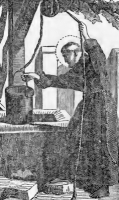
• John Hesychastes
• John Sabaites
• John Silentiarius
• John the Silent
Son of Enkratios, a military commander, and Euphemia; his brother and other family members were advisors to emperors. John received an excellent secular and religious education. His parents died in 471, and at age 18 John used his inheritance to build the Church of the Most Holy Mother of God in Nicopolis. By age 20 he had founded a monastery for himself and ten fellow young monks. Bishop of Colonia (Taxara) by age 28; ecclesiastical duties permitting, he continued to live as a monk.
In his tenth year as bishop, his brother-in-law, Pazinikos, was appointed governor of Armenia, and immediately began meddling in Church affairs. Overwhelmed by secular matters he was not prepared for, he secretly fled to Jerusalem, praying for a place to hide from the world. Accepted as a novice at Saint Sabas monastery, working as a steward and construction worker. After four years at the monastery, he was being considered for ordination, and felt compelled to reveal his secret life to the Jerusalem Patriarch Elias. Elias permitted him to take a vow of silence, and wall himself into his cell for another four years.
Lived as a hermit in a hut built against a rock face in the desert wilderness for nine years; legend says he was protected from brigands by a lion that stayed nearby. Saint Sava convinced John to return to the monastery. His secret came out, and he lived many years at the monastery under the protection of Sava. Late in life he left his solitude to fight the Origenists. Miracle worker. Healer. Exorcist.
8 January 454 at Nicopolis, Armenia
8 January 558 in Jerusalem of natural causes
bishop with a finger to his lips
https://catholicsaints.info/saint-john-the-silent/
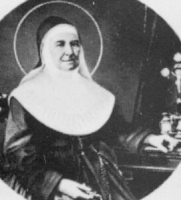
• Benedetta Rossello
• Benedicta Rossello
• Josepha Rossello
• Maria Giuseppe Rossello
• Maria Joseph Rollo
• Sister Mary-Joseph
One of nine children, her father was a potter. Born in poverty, she suffered from poor health all her life. Pious from early youth she tried to enter a religious order, but was refused admission due to her health and lack of dowry. The pious, childless couple she worked for could have given her a dowry, but would not because they did not want to lose her as member of their family. Franciscan tertiary at age 16.
Her bishop knew of her skill in teaching the faith to girls, and in 1837 he gave her a house which she and three other young women made into two classrooms. From this humble beginning came the Institute of the Daughters of Mercy in 1837 under the protection of Our Lady of Mercy and Saint Joseph, groups devoted to teaching the young, and caring for the sick. Any deserving girl would be accepted into the community, even without a dowry. Mary Joseph served as superior of this band of teachers for over 40 years. In 1875 they opened their first house in the Americas at Buenos Aires, Argentina.
Josepha's success and personal holiness were such that her bishop, over strong objection from many, allowed her to organize a group that encouraged vocations to the priesthood.
1811 at Albissola Marina, Liguria, diocese of Savona, Italy as Benedetta Rossello
7 December 1888 at Savona, Italy of natural causes
1949 by Pope Pius XII
The hands should be at work, the heart with God. - Saint Mary Joseph
https://catholicsaints.info/saint-mary-joseph-rosello/
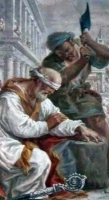
• Sabino of Assisi
• Sabinus, Savino
Bishop, possibly of Spoleto, Italy, during the persecutions of Diocletian; he was imprisoned in Assisi and Spoleto, Italy. As punishment for continuing to spread Christianity in defiance of imperial decrees, Sabino had his hands amputated so he could live on as an example to others. While imprisoned, Sabino restored the sight of a blind fellow prisoner. The prison's executioner, who had chopped off the hands, suffered from an eye disease and went to see Sabino; the bishop healed the man, and talked to him about Christianity; the other guards were so angry at the continual defiance, they beat Sabino to death. Martyr.
• beaten by prison guards c.303 in Spoleto, Italy
• some relics stolen in 954 by Duke Conrad of Spoleto, and taken to Ivrea, Italy in order to combat an epidemic that was raging in the city; miracles reported in connection with the relics, and they were processed through the center of the old city every 7 July for centuries
• Fermo, Italy
• Ivrea, Italy
• blind or blindfolded bishop
• bishop having his hands cut off
• bishop with no hands preaching
https://catholicsaints.info/saint-sabinus-of-spoleto/
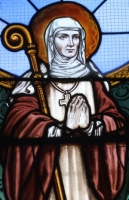
Burgondophora, Fare, Fara
Sister of Saint Cagnoald and Saint Faro of Meaux; daughter of Count Agneric, courtier of King Theodebert II. As a baby, she was blessed by Saint Columbanus.
Burgundofara was early drawn to a religious vocation, despite her father's fierce opposition. He demanded that she marry, and arranged a marriage for her. The girl became deathly ill, and when she was miraculously healed by Saint Eustace, Burgundofara's father gave in, and built his daughter a convent. It followed the Rule of Saint Columban, and is now known as the Benedictine abbey of Faremoutiers.
Abbess for 37 years, noted for her piety and administrative skill. She trained many English nun-saints, including Saint Ethelburga. Bede refers to her, which led to the mistaken idea that she died in England.
595 in Burgundy, France
643 or 655 or 657 near Meaux, France (records vary) of natural causes
Faremoutiers, France
• abbess with an ear of corn
• a child being blessed by Saint Columbanus
https://catholicsaints.info/saint-burgundofara/
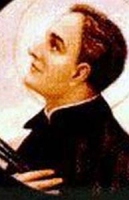
• 19 October as one of the Martyrs of North America
• 26 September in Canada
Son of the wealthy Jean G and Anne de Garault. A studious lad whose health was never strong, he early felt a call to religious life. Studied classics, philosophy and theology at the Jesuit college of Clermont, France. Joined the Jesuits in 1624. Ordained in 1634. Missionary to Canada in 1636. Missionary to the Huron for 13 years, one of the famous "black robes" who lived in terrible conditions to bring the faith to the far north. Died when the fort at which he was stationed was attacked by Iroquois. Charles spent his last hours ministering to the dying before he was murdered. Martyr.
1606 in Paris, France
shot in the chest and abdomen, and tomahawked in the head on 7 December 1649 at Fort Saint Jean, Canada
29 June 1930 by Pope Pius XI
https://catholicsaints.info/saint-charles-garnier/
Athenodoros
Tortured and martyred in the persecutions of Eleusis and Diocletian.
• sentenced to be burned at the stake in 304 in Mesopotamia, but the fire would not light
• sentenced to be beheaded, but the executioner dropped dead when he approached Athenodorus
• while another solution was sought, Athenodorus began to pray, and he died quietly
https://catholicsaints.info/saint-athenodorus-of-mesopotamia/
Married to the daughter of his employer, a wealthy merchant. Moved to Novgorod with the business. Widower. Monk in Kensk. Hermit in the forest around the White Sea. His reputation for holiness attracted disciples, and the Prince of Moscow built a monastery for them. In his later years, Antonius tried to retire to live as a hermit again, but his brother monks followed him.
Archangel, Russia
1556
https://catholicsaints.info/saint-antonius-of-siya/
Benedictine monk at Chaise-Deux. Monk at Clairvaux Abbey in 1117. Prior at Clairvaux, appointed by Saint Bernard. Abbot at Igny, France in 1127. Humbert tried to return to Clairvaux, but was ordered back to Igny by Bernard under pain of monastic excommunication. Bernard delivered a touching homily at Humbert's funeral Mass.
1148
https://catholicsaints.info/blessed-humbert-of-clairvaux/
Soldier in Alexandria, Egypt. When he prevented a mob of pagans from desecrating the bodies of Christian martyrs killed in the persecutions of Decius, the mob dragged him to court where he confessed to being a Christian himself. Martyr.
martyred in 250 in Alexandria, Egypt
https://catholicsaints.info/saint-agatho-of-alexandria/
Born to the nobility. A layman, he was tortured and murdered in the persecutions of the Arian Vandal King Hunneric for adhering to orthodox Christianity.
African
beaten and then dragged over stones until dead in 484 in North Africa
https://catholicsaints.info/saint-servus-the-martyr/
• Buithe mac Bronach
• Boethius, Buite
Pilgrim to Rome who studied in Italy, then returned to Scotland to work as a missionary to the Picts.
Scotland
521
https://catholicsaints.info/saint-buithe-of-monasterboice/
Spiritual student of Saint Sabas of Pskov. Hermit in the forests in the Tver region. He attracted so many would be students that he moved to a deserted island in Lake Seliguer.
1554 of natural causes
https://catholicsaints.info/saint-nilus-of-stolbensk/
First bishop of Piacenza, Italy, a flock he served for over 50 years. Staunch opponent of Arianism. Attended the Council of Sardica.
375 of natural causes
https://catholicsaints.info/saint-victor-of-piacenza/

Sixth century bishop of Bayeux, France.
https://catholicsaints.info/saint-geretrannus-of-bayeux/
Missionary and evangelizing bishop in Mercia, England. The modern town of Peterborough, England, grew up around a monastery he founded.
Ireland
658
https://catholicsaints.info/saint-diuma/
Spiritual student of Saint Martin of Tours. Founded the monastery of Saujon, France.
c.400
https://catholicsaints.info/saint-martin-of-saujon/
Agnan of Chartres
Fifth century bishop of Chartres, France.
https://catholicsaints.info/saint-anianas-of-chartres/
Bishop of Teano, Campania, Italy.
c.356
https://catholicsaints.info/saint-urban-of-teano/
martyred in Antioch
https://catholicsaints.info/saint-polycarp-of-antioch/
martyred in Antioch
https://catholicsaints.info/saint-theodore-of-antioch/
CatholicSaints.Info Portable Edition